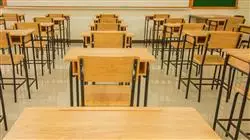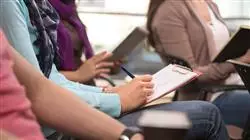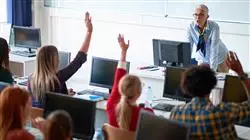University certificate
The world's largest faculty of education”
Why study at TECH?
This Postgraduate diploma will show you the New perspectives in the teaching of Spanish Language and Literature"

In a digitalized world where images seem to be winning the race against writing and oral communication, the Spanish Language and Literature teacher faces a challenge in order to promote writing and reading in High School Education students.
An attractive challenge for those who wish to improve in this field and who, to do so, are looking for learning that will allow them to progress as a teacher in an environment that requires active listening to students and the application of the latest technological advances. In this sense, TECH provides, in this Postgraduate diploma in Teacher Training of Spanish Language and Literature in High School Education, the most advanced syllabus on the learning processes currently required.
A 6-month program that will take students into the evolution of subject content, learning methods, syllabus design, and the teaching of Language and Literature using the most innovative pedagogical systems. This content is complemented by the multimedia resources that make up the library, which can be accessed at any time of the day from a computer, tablet, or cell phone with an Internet connection.
In addition, in this program the teacher will not invest a great amount of hours of study and memorization, thanks to the Relearning system used by this educational institution. A method based on the reiteration of content, which will allow you to consolidate your knowledge while progressively advancing through the syllabus.
A unique opportunity to advance in the Education sector through a quality, flexible and compatible university program that is flexible and compatible with daily professional and personal responsibilities.
In only 6 months you will achieve remarkable progress as a teacher of Spanish Language and Literature thanks to this university program"
This Postgraduate diploma in Spanish Language and Literature Teacher Training in High School Education contains the most complete and up-to-date educational program on the market. The most important features include:
- Practical cases presented by experts in education
- The graphic, schematic, and practical contents with which they are created, provide practical information on the disciplines that are essential for professional practice
- Practical exercises where self-assessment can be used to improve learning
- Its special emphasis on innovative methodologies
- Theoretical lessons, questions to the expert, debate forums on controversial topics, and individual reflection assignments
- Content that is accessible from any fixed or portable device with an Internet connection
Enroll now in a 100% online university program that is compatible with your daily professional and personal responsibilities"
The program’s teaching staff includes professionals from the field who contribute their work experience to this educational program, as well as renowned specialists from leading societies and prestigious universities.
The multimedia content, developed with the latest educational technology, will provide the professional with situated and contextual learning, i.e., a simulated environment that will provide immersive education programmed to learn in real situations.
This program is designed around Problem-Based Learning, whereby the professional must try to solve the different professional practice situations that arise during the educational year. For this purpose, the students will be assisted by an innovative interactive video system created by renowned and experienced experts.
Become an excellent teacher with a wide range of skills to enhance your students' creative writing"

A program with which you will be able to deepen your knowledge of students with speech and language development Disorders"
Syllabus
This Postgraduate diploma has been designed to provide the teaching professional with the tools, techniques and methodologies necessary to successfully teach the subject of Spanish Language and Literature in High School Education. In this way, you will find in this advanced program, which covers the main complements for the disciplinary training of this area, the syllabus design and the teaching of this subject. It also has a library of teaching resources that can be accessed at any time of the day, from an electronic device with an Internet connection.

An advanced syllabus that will allow you to improve the teaching of written and oral language in High School Education students”
Module 1. Complements for the Disciplinary Training of Spanish Language and Literature
1.1. History of Language: Evolution of the Contents and the Way the Subject is Taught from the 20th Century to the Present Day
1.1.1. Tradition in Spanish Language Content
1.1.2. The Contents in the Traditional Grammar and the Current Grammar
1.1.3. The Study of Grammar and the Contents of Communication
1.1.4. Language Teaching Methodology
1.1.5. Grammar-Translation and Communicative Approach
1.1.6. New Perspectives in Language Teaching
1.2. History of Literary Education in the Hispanic World. Didactic Models in the Teaching of Literature
1.2.1. The History of Literary Education in the Hispanic World
1.2.2. Didactic Models in the Teaching of Literature
1.3. History of Literature: Evolution of the Way of Teaching the Subject from the 20th Century to the Present Day
1.3.1. The Context of the Teaching
1.3.2. Literature as a Discipline
1.3.3. Literature as a Communicative Phenomenon
1.3.4. Canon
1.3.5. Teaching Literature: a Little Bit of History
1.4. Pragmatics. Text Linguistics and its Properties
1.4.1. Pragmatics.
1.4.2. Text Linguistics
1.4.3. Text and Its Properties
1.4.4. Modalization
1.4.5. Polyphony
1.4.6. Textual Typologies
1.5. Classification of Text Types according to the Form of Discourse: Descriptive, Narrative, Dialogic, Expository and Argumentative Texts
1.5.1. General Ideas
1.5.2. Descriptive Texts
1.5.3. Narrative Texts
1.5.4. Dialogic Texts
1.5.5. Expository Texts
1.5.6. Argumentative Texts
1.6. Classification of Text Types according to the Use of Language: Scientific and Technical Texts; Legal-Administrative Texts; Journalistic and Advertising Texts
1.6.1. Scientific Texts
1.6.2. Scientific and Technical Texts
1.6.3. The Legal-Administrative Texts
1.6.4. Journalistic Texts and their Language
1.6.5. Advertising Texts and their Influence on Social Communication
1.6.6. Literary Texts and the Importance of Aesthetic Pleasure
1.7. Classification of Texts according to the Intention of the Sender, according to the Linguistic Variety and according to the Channel Used
1.7.1. Types of Texts according to the Sender's Intention
1.7.2. Types of Texts according to the Linguistic Variety
1.7.3. Types of Texts according the Channel Used
1.8. Text Commentary
1.8.1. History and Evolution of Text Commentary
1.8.2. Comprehension and Interpretation of Texts
1.8.3. Guide for Writing a Literary Text Commentary
1.9. Study of Language and Literature as Cultural Development: Education in Values through Literature and Correctness in Oral and Written Expression
1.9.1. Linguistic Factors and Misunderstandings
1.9.2. Cultural Stereotypes through Language and Literature
1.9.3. Language, Literature and Culture
1.10. Dialogical Literary Discussion Groups
1.10.1. The Origin of Dialogic Literary Gatherings
1.10.2. Interactions That Speed Up Reading
1.10.3. Classics in Preschool and Primary School
1.10.4. The Functioning of the Discussion Group
1.10.5. Other Dialogical Discussion Groups
Module 2. Spanish Language and Literature Syllabus Design
2.1. Syllabus and its Structure
2.1.1. School Syllabus: Concept and Components
2.1.2. Syllabus Design: Concept, Structure and Functioning
2.1.3. Levels of Syllabus Specification
2.1.4. Syllabus Model
2.1.5. Educational Programming as a Working Tool in the Classroom
2.2. Legislation as a Guide to Syllabus Design and Key Competencies
2.2.1. Review of Current National Educational Legislation
2.2.2. What are Competencies?
2.2.3. Types of Skills
2.2.4. Key Competencies in LOE-LOMCE
2.2.5. Description and Components of Key Competencies LOMCE
2.3. The Spanish Education System Teaching Levels and Modalities
2.3.1. Education System: Interaction between Society, Education and the School System
2.3.2. The Educational System: Factors and Elements
2.3.3. General Characteristics of the Spanish Educational System
2.3.4. Configuration of the Spanish Educational System
2.3.5. Compulsory High School Education
2.3.6. Vocational Training, Artistic, Language, Sports, and Adult Education
2.4. The Language and Literature Syllabus
2.4.1. Definition of the Concept of a Syllabus
2.4.2. The Elements and Parts of the Syllabus
2.4.3. The Syllabus of Language and Literature in Elementary Education
2.4.4. The Language and Literature Syllabus in High School Education
2.5. Educational Programming I
2.5.1. Importance of Educational Programming
2.5.2. Components
2.5.3. Justification
2.5.4. Objectives: Types
2.5.5. Objectives: Sources
2.5.6. Objectives: Formulation
2.5.7. Content: Types
2.5.8. Content: Selection and Organization Criteria
2.5.9. Content: Sequencing Criteria
2.6. Educational Programming II
2.6.1. Key Competencies
2.6.2. Methodology: Methodological Principles
2.6.3. Methodology: Area
2.6.4. Methodology: Methodological Strategies
2.6.5. Attention to Diversity
2.6.6. Resources
2.6.7. Assessment
2.6.8. Timing
2.6.9. Other Elements
2.6.10. Relationship Between the Elements of the Syllabus in the Educational Programming
2.7. Teaching Units II
2.7.1. Methodological Strategies: Methods and Techniques
2.7.2. Activities: Their Role in Teaching Unit
2.7.3. Activities: Classification
2.7.4. Activities: Characteristics
2.7.5. Sequence of Activities
2.7.6. Attention to Diversity
2.7.7. Resources
2.7.8. Evaluation: Instrument Selection
2.7.9. Evaluation: Student Qualification
2.7.10. Assessment of a Mathematics Teaching Unit
2.8. Design of Educational Programming for Language and Literature
2.8.1. Characterization of the Material
2.8.2. Contribution of the Subject to the Development of Key Competencies
2.8.3. Communicative Approach
2.8.4. Communication Projects
2.8.5. Selection and Prioritization of the Content
2.8.6. Oral Comprehension and Production
2.8.7. Interaction
2.8.8. Reading
2.8.9. Written production
2.8.10. Literary Education
2.9. Example of a Teaching Unit for Spanish Language: Advertising
2.9.1. Elements of the Programming Table
2.9.2. Description of Activities
2.9.3. Methodological guidelines
2.9.4. Guidelines for Evaluation
2.10. Example of a Teaching Unit for Spanish Literature
2.10.1. The Task-Based Approach
2.10.2. The Teaching of Language and Literature
2.10.3. Literature in the Task-Based Approach
2.10.4. Teaching Proposal: Spanish Lyric Literature in the 16th Century
Module 3. Spanish Language and Literature Teaching
3.1. Teaching Language and Literature
3.1.1. Introduction to the Concept of Teaching
3.1.2. Teaching Language
3.1.3. Teaching Literature
3.1.4. Teaching from a Cultural Perspective
3.2. Theories of Learning Applied to the Specialty I: Overview
3.2.1. The Main Streams of Learning Theories
3.2.2. Theories of Learning, Language and Literature
3.2.3. New Trends in Learning Theories
3.3. Learning Theories Applied to the Specialty II: Meaningful Learning and Language Proficiency Learning
3.3.1. The Role of Meaningful Learning
3.3.2. The Basic Elements of Meaningful Learning
3.3.3. Meaningful Learning in Teaching Tasks
3.3.4. Definition of the Linguistic Domain
3.3.5. Characterization of the Linguistic Domain
3.3.6. Teaching Tasks and Linguistic Domain
3.4. Oral Language Didactics
3.4.1. Elements of Oral Proficiency
3.4.2. Characteristics of Oral Language
3.4.3. Teaching Oral Communication
3.4.4. Teaching Proposals
3.5. Written Language Didactics
3.5.1. Definition of the Concept of Written Language
3.5.2. Key Elements in the Teaching Written Language
3.5.3. ICT in Teaching Language
3.5.4. Written Language Evaluation
3.6. Speech and Language Development Disorders
3.6.1. The Architecture of the Mind
3.6.2. The Language
3.6.3. Language Development
3.6.4. Communication Disorders
3.6.5. Specific Speech and Language Development Disorders
3.6.5.1. Specific Developmental Speech and Language Disorder
3.6.5.2. Speech Development Disorders
3.7. Creative Writing
3.7.1. Methodological Focus of Written Expression
3.7.2. The Phases in the Writing Process
3.7.3. Proposal of Writing Activities
3.7.4. Writing Assessment
3.8. Reading
3.8.1. Introduction: What is Reading?
3.8.2. Reading Comprehension
3.8.3. Teaching Reading
3.9. TIC for Language and Literature
3.9.1. Outlines, Concept, and Mind Maps
3.9.2. Infographics
3.9.3. Presentations and Moving Texts
3.9.4. Creation of Videos and Tutorials
3.9.5. Gamification
3.9.6. Flipped Classroom
3.10. Assessment
3.10.1. The Classroom as an Evaluation Context
3.10.2. Types of Evaluations
3.10.3. Traditional Assessments
3.10.4. Current Assessments
3.10.5. How to Evaluate: Techniques and Instruments
3.10.6. Selection of Instruments and Techniques
3.10.7. What to Evaluate?
3.10.8. Evaluation Meetings
3.10.9. Program Evaluation
3.10.10. Evaluation Together with the Teaching Staff

Use in your Spanish Language and Literature classes the latest technological innovations oriented to playful learning"
Postgraduate Diploma in Spanish Language and Literature Teacher Training in High School Education
If you are passionate about teaching Spanish Language and Literature in Secondary Education, TECH Global University's Postgraduate Diploma is the perfect opportunity to elevate your pedagogical skills. Through our high quality virtual classes, you will be able to acquire the knowledge and strategies necessary to provide an excellent education over a period of 6 months. We focus on offering you cutting-edge academic programs that boost your professional development. Our Postgraduate Diploma is taught in virtual mode, which allows you to study from anywhere and adapt your learning schedule to your daily responsibilities. You will be guided by leading experts in the teaching of Spanish Language and Literature, who will provide you with the necessary tools to create stimulating and motivating learning environments.
Power your pedagogical skills with TECH Global University.
During the program, you will learn about innovative methodologies, didactic resources and effective assessment techniques, all geared towards enhancing the development of your students' linguistic and literary skills. Our virtual classes will give you the opportunity to interact with other teachers, exchange experiences and share best practices. You will also have access to updated materials and a virtual platform that will facilitate your learning process and allow you to deepen your knowledge of the contents of each module. At the end of the program, you will obtain a certificate, endorsed by TECH. This official recognition will highlight your skills and knowledge as a teaching professional, opening up new opportunities for growth and development. Enroll and become a benchmark in teaching this discipline - your success is just a click away!""







